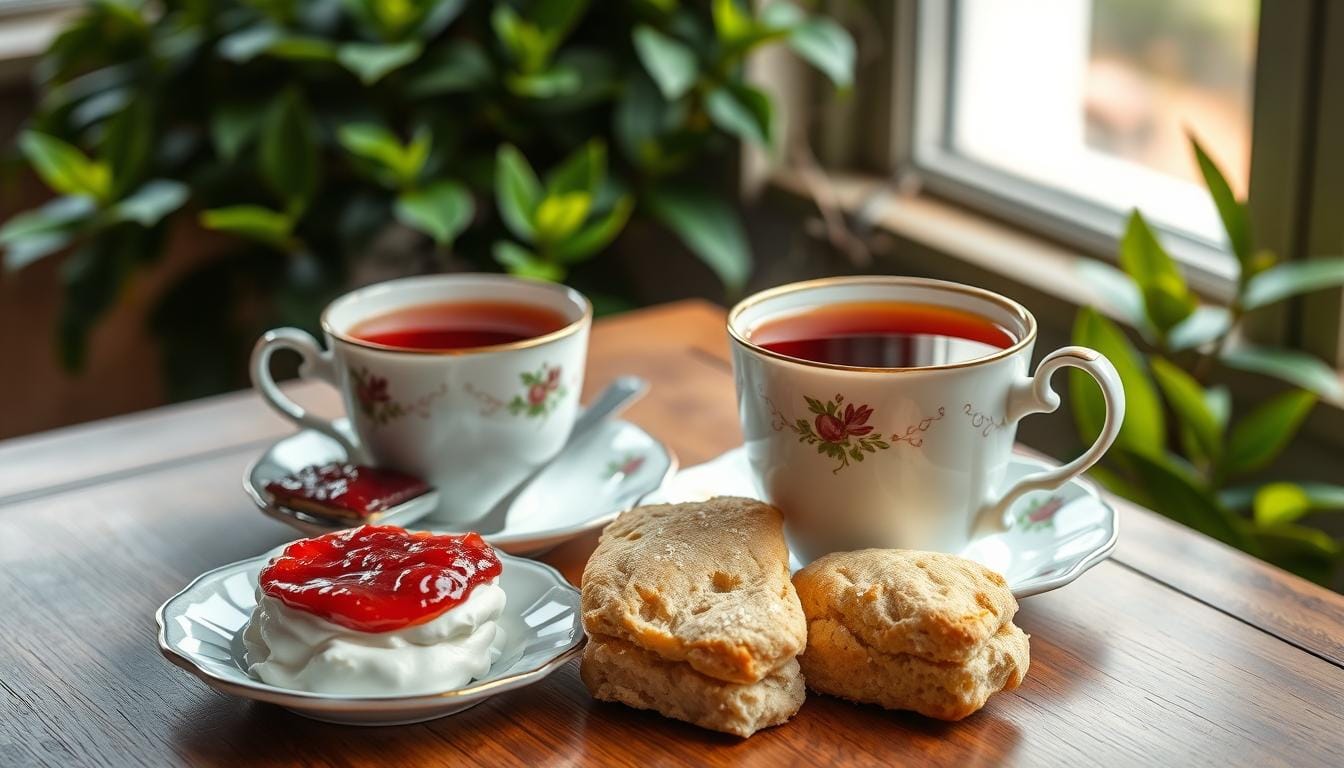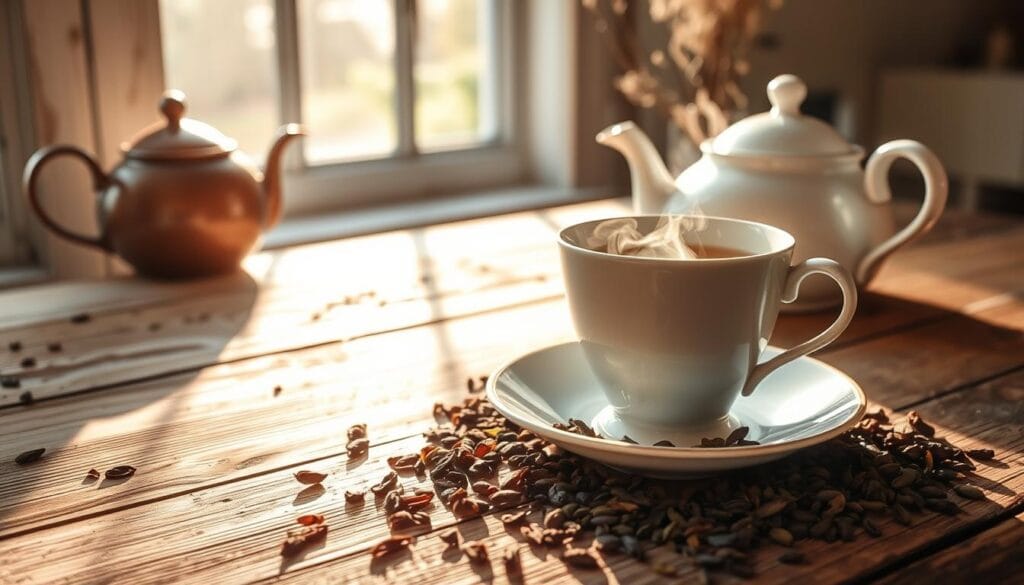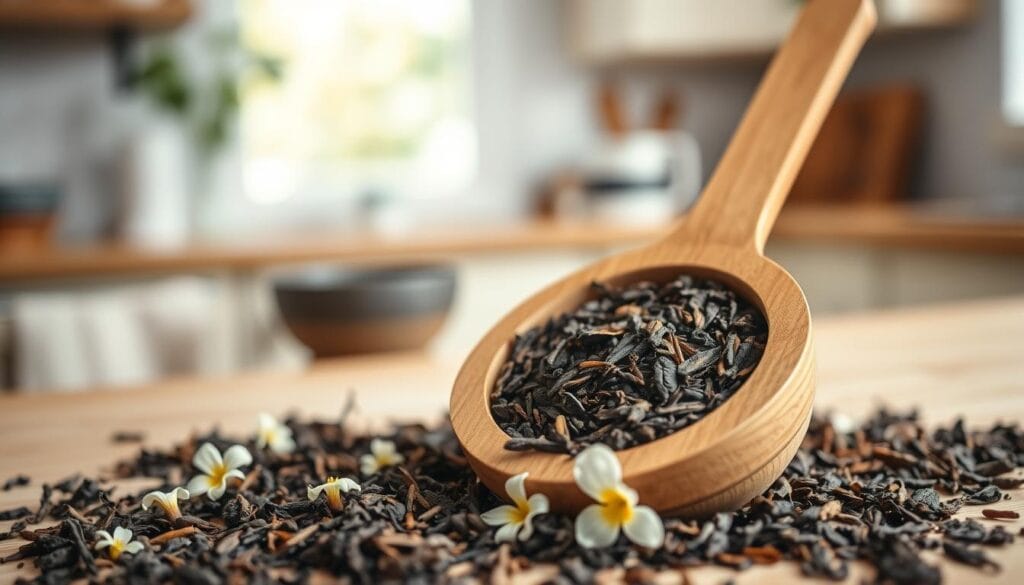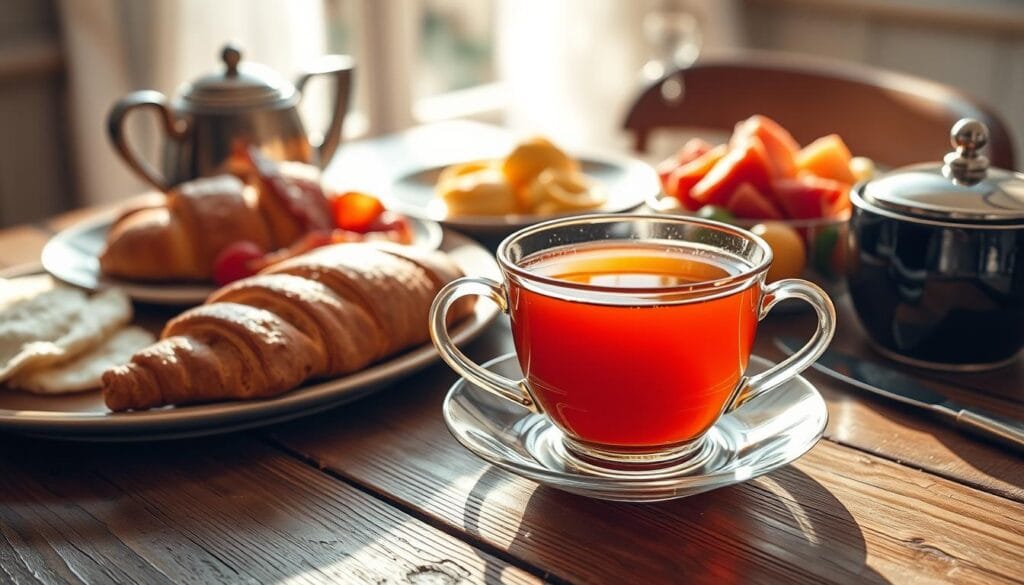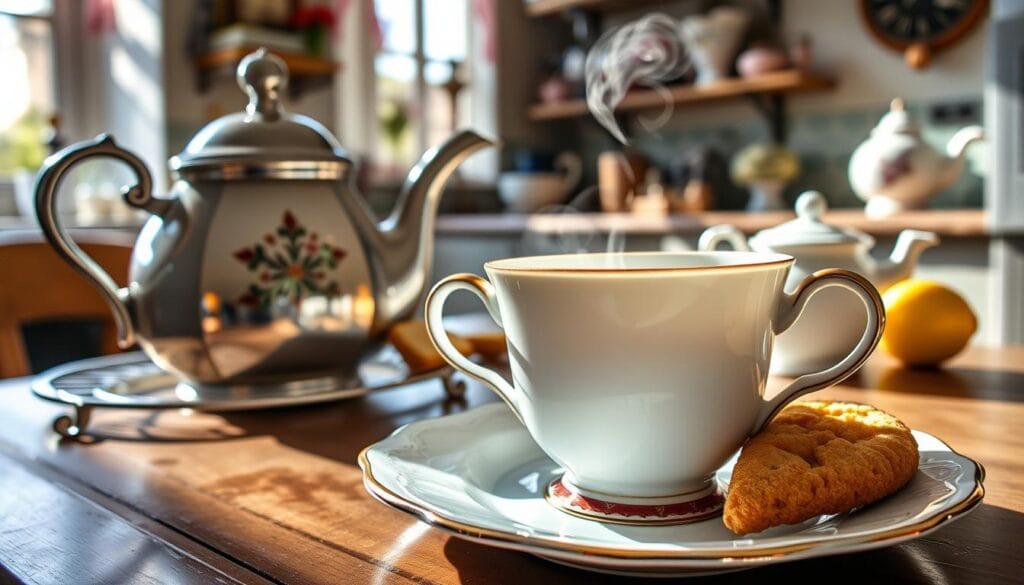As the sun rises, the aroma of English Breakfast tea fills the air. It invites you to start your day with a comforting ritual. This beloved black tea blend has a rich history that spans continents and captivates tea enthusiasts worldwide.
From its origins in the 19th century to its enduring popularity today, English Breakfast tea has become a cherished part of morning routines. It offers a robust and aromatic experience that pairs perfectly with a hearty breakfast.
Whether you savor it in the comfort of your own home or enjoy it as a companion to your morning commute, English B tea has a way of grounding us. It provides a moment of calm amidst the bustling day. Its distinct flavor profile, crafted from a harmonious blend of teas, creates a strong and aromatic experience that has captivated tea drinkers for generations.
What is English Breakfast Tea?
English Breakfast Tea is a classic black tea blend known for its strong, full-bodied flavor. It comes from the United Kingdom and is loved worldwide as a morning drink. The blend mixes black teas from places like Assam, Ceylon, and Kenya. Each adds its own special touch to make a refreshing and energizing tea.
Definition and Origins
The name “English Breakfast Tea” has been around since the late 18th century. It was used to describe a strong black tea blend. Some say it was made in Scotland in 1843, while others believe it was Richard Davies, a tea merchant in New York, who created it.
But it’s clear that English B Tea became very popular in the Victorian era in Great Britain. This was when tea became more available to everyone, not just the rich.
Varieties of English Breakfast Tea
- Traditional English B Tea: A strong mix of black teas, often with Assam, Ceylon, and Kenyan teas.
- Premium English B Tea: These are higher-quality blends with extra black tea varieties, like Keemun, for a richer taste.
- Organic English B Tea: This is a greener option, using organic black tea leaves that are grown sustainably.
- Flavored English B Tea: These blends add spices, fruits, or herbs to create new and exciting tastes.
All types of English B Tea share a strong, bold flavor. This makes them perfect for starting your day off right.
The Ingredients Behind the Blend
To make a classic English Breakfast tea, tea blenders pick the best black tea leaves from all over the world. They mix these leaves to create a strong, full-bodied, and aromatic loose leaf tea. This tea is loved by many and is a common choice in homes everywhere.
Types of Tea Leaves Used
English Breakfast tea is made from a mix of black teas. The main types are:
- Assam tea from India, which adds malty and slightly bitter flavors
- Ceylon tea from Sri Lanka, bringing refreshing pine and sour tastes
- Keemun tea from China, adding citrusy and smoky notes
- Kenyan black tea, adding fruity and floral hints
By carefully choosing and mixing these teas, they create a perfect tea blend. This blend is more than just the sum of its parts.
Flavor Profiles and Aromas
The English Breakfast aromatic tea is known for its robust and malty taste. It also has subtle citrus and honey notes. This complex flavor is great with milk and sugar, making it a favorite for breakfast and all day.
“A good English B tea should be strong, rich, and refreshing, making it suitable for consumption throughout the day.”
Health Benefits of English Breakfast Tea
English B tea is not just tasty; it’s also good for you. It’s full of antioxidants, nutrients, and compounds that boost your health. It’s a great way to start your day.
Antioxidant Properties
English B tea is loaded with flavonoids, lipoproteins, and polyphenols. These include catechins, thearubigins, and theaflavins. They fight off free radicals, which can lower heart disease and cancer risks.
Studies show black tea, the base of English breakfast, can lower cholesterol and improve blood flow.
Boosting Energy Levels
English B tea has 30 to 70 mg of caffeine per cup. It gives you energy without the jitters. This is thanks to L-theanine, which works with caffeine to sharpen your mind.
The tea also has vitamins and minerals like vitamin B and magnesium. They help increase energy and vitality.
Looking for a healthier morning drink? English B tea is a great choice. It’s full of benefits and tastes amazing.
“The health benefits of English breakfast tea have been supported by peer-reviewed research, making it a flavorful and wise choice to start the day.”
How to Brew the Perfect Cup
To make a great cup of English B tea, focus on the details. Use filtered water heated to about 90°C (194°F). For loose leaf tea, use two teaspoons for every 250ml of water.
Steep the tea for 2-3 minutes. Adjust this time to get the strength you like. The longer it steeps, the stronger and darker the tea will be.
Choosing the Right Water
The water’s quality greatly affects your tea’s taste. Use filtered water to remove impurities. Avoid water that’s been boiled too many times, as it can taste flat.
Steeping Times and Temperatures
For loose leaf tea, the best water temperature is 90°C to 95°C (194°F to 203°F). Boiling water can make the tea taste bitter. Steep the tea for 2-3 minutes for a medium strength. Adjust this time to suit your taste.
English Breakfast tea is often served with milk. You can also enjoy it plain or with lemon. Traditionally, milk was added first to prevent fine china from cracking.
“The key to a perfect cup of English B tea is to pay attention to the details – the water temperature, steeping time, and the right ratio of tea leaves to water. With a little practice, you’ll be brewing cafe-worthy tea at home in no time.”
Pairing English Breakfast Tea with Food
English B tea is perfect for the morning. It’s a strong and tasty black tea that goes well with many breakfast foods. You can enjoy it with both hearty and light dishes, making every morning special.
Breakfast Foods to Complement the Tea
English B tea is great with savory breakfasts. Try it with a full English breakfast of eggs, sausages, bacon, and toast. Its bold taste balances the meal’s richness.
For a lighter option, it’s also good with egg dishes like scrambled eggs or poached eggs on avocado toast.
Snack and Dessert Pairings
- Scones or flaky biscuits with clotted cream and preserves
- Buttery croissants or pastries
- Fruit tarts or crumbles
- Banana bread or muffins
- Granola or oatmeal with fresh fruit
English B tea is also great with sweet treats. It’s perfect for afternoon tea or a weekend brunch. Its strong flavor cuts through the richness of desserts, creating a perfect balance.
The art of pairing tea with food is always growing. English B tea offers endless possibilities for enjoying your morning. Whether you stick to traditional tea or try new flavors, this tea will make your mornings better.
Popular Brands of English Breakfast Tea
English B tea is a classic British favorite. Many brands offer their take on this beloved tea. You can find everything from traditional flavors to new twists.
Twinings
Twinings is one of the oldest tea brands. They’ve been making English B tea for centuries. Their blend combines teas from Kenya, Indonesia, Assam, Malawi, and China. This creates a full-bodied flavor that’s a British staple.
Harney & Sons
Harney & Sons is known for quality teas. Their English B tea blends black teas from India and Sri Lanka. It’s a rich, robust cup with a lovely aroma and flavor.
Other Notable Options
There are many other brands that offer their own English B teas. Some include:
- Yorkshire Tea, known for its bold flavor
- PG Tips, loved for its smooth taste
- Tetley, a trusted name for traditional English B tea
Some brands also offer decaf or organic options. These are great for those watching their diet or health.
| Brand | Rating (out of 5) |
|---|---|
| Teakruthi Colonial Mornings | 3.9 |
| Whittard English B Tea | 3.5 |
| Hampstead English B Tea | 3.5 |
| New English Teas English Breakfast | 3.5 |
| T2 English Breakfast | 3.4 |
When picking an English B tea, think about what you like. Do you want loose-leaf or bagged? Do you like more or less caffeine? Trying different brands can help you find your favorite.
Brewing Techniques: Traditional vs. Modern
The art of brewing the perfect cup of English B tea has changed over time. Both traditional and modern methods are popular among tea lovers. Traditional methods use a classic teapot and loose leaf loose leaf tea or tea bags. The tea steeps for several minutes to bring out its bold flavor.
The debate over adding milk before or after pouring the tea shows the ritual and nuance of this brewing process.
Modern innovations offer more convenient and precise brewing options. Electric kettles with temperature control, tea infusers for loose leaf teas, and cold brew methods for iced tea are popular. Some tea enthusiasts experiment with brewing times and temperatures to find different flavors in the strong tea.
Traditional Brewing Methods
The traditional way to brew English B tea uses a ceramic or porcelain teapot. The right amount of loose leaf tea or tea bags is measured out. The tea steeps in hot water for 3 to 5 minutes to get its full-bodied flavor.
The debate over adding milk before or after pouring the tea is a long-standing tradition. It can change the taste and look of the final drink.
Modern Innovations
Modern brewing techniques have come up to meet the changing tastes of tea drinkers. Electric kettles with precise temperature controls help heat the water perfectly. This ensures the best brewing temperature for the tea leaves.
Tea infusers are popular among loose leaf tea fans. They make steeping the leaves easy without the mess of a traditional teapot. Cold brew methods are also popular for making refreshing iced tea. They offer a unique flavor compared to hot brewing.
Even with modern innovations, many tea lovers still prefer the traditional method. They love the ritual and the full-bodied taste it offers. The debate between traditional and modern brewing continues. Tea enthusiasts keep exploring both to find their favorite way to enjoy English B tea.
Exploring Alternative Breakfast Teas
While English Breakfast Tea is a classic, there are other strong and tasty breakfast teas to try. Scottish Breakfast Tea and Irish Breakfast Tea are two such options. They each bring a special twist to the traditional breakfast tea experience.
Scottish Breakfast Tea
Scottish Breakfast Tea is stronger and more full-bodied than English Breakfast. It often has more Assam tea, giving it a malty, oaky, and smoky taste. This flavor is perfect for the hearty breakfasts of Scotland. With a caffeine level of 5 out of 5, it’s the strongest of the three, making it a great morning pick-me-up.
Irish Breakfast Tea
Irish Breakfast Tea has a robust, malty flavor and a reddish color. It usually has more Assam tea leaves. This blend is earthy and malty, making it great with Irish breakfasts. Like Scottish Breakfast Tea, it also has a caffeine level of 5 out of 5, ideal for those who like a strong black tea in the morning.
These teas cater to different tastes and cultural preferences. Scottish and Irish blends are bolder, matching the hearty breakfasts of their regions. Each offers a unique experience while keeping the strong flavor of breakfast teas.
| Breakfast Tea Blend | Tea Leaves Used | Caffeine Strength | Flavor Profile |
|---|---|---|---|
| English Breakfast | Ceylon, Keemun | 4/5 | Bright, rich |
| Scottish Breakfast | Ceylon, Yunnan | 5/5 | Malty, oaky, smoky |
| Irish Breakfast | Ceylon, Assam | 5/5 | Earthy, malty |
Whether you like the classic English Breakfast, the bold Scottish Breakfast, or the robust Irish Breakfast, there’s a tea for you. Try different blends to find the perfect one for your taste and morning routine.
How to Store English Breakfast Tea Properly
Storing your loose leaf tea right is key to keeping its flavor fresh. English Breakfast tea is no exception. Follow these tips to keep your tea tasting great.
Ideal Storage Conditions
For English Breakfast tea to stay fresh, store it in an airtight container. Keep it away from light, heat, moisture, and strong smells. The best spot is a cool, dark place like a pantry or kitchen cabinet. Temperatures between 60°F and 80°F are ideal.
Don’t store tea in the fridge or freezer. The moisture can make the leaves go bad faster.
Shelf Life and Freshness
Loose leaf English Breakfast tea can stay flavorful for up to two years if stored right. Tea bags last about a year. But for the best taste, drink your tea within six months to a year.
If your tea tastes flat, try adding more tea bags. It can bring back the flavor.
“Proper storage is the key to enjoying the full character and complexity of your English B tea. Protect it from light, air, and odors, and you’ll be rewarded with a flavorful cup every time.”
English Breakfast Tea in Different Cultures
English B Tea is a big part of British culture. It’s a key part of their traditional breakfast and afternoon tea. It’s a comforting drink that many people enjoy every day.
While it’s a big part of British identity, it’s also loved worldwide. People have made their own versions of this tea. They’ve also found new ways to brew it.
Its Role in British Culture
In the UK, English B Tea is a favorite morning drink. It’s often taken with milk and sugar, part of the full English breakfast. Drinking this tea is a big part of British life.
It’s more than just a drink. It’s a symbol of tradition and comfort. You can find it in homes, cafes, and even fancy places all over the country.
Global Adaptations of the Blend
The world loves English B tea too. In the US, it’s a morning favorite, and some like it iced. In Australia and New Zealand, it’s a common tea to drink all day.
But, interestingly, it’s not the most popular tea in the UK. That title belongs to East Frisia in Germany. This shows how English B Tea has become a global drink. It shows how different cultures enjoy tea in their own ways.
FAQ
What is English Breakfast Tea?
English Breakfast Tea is a black tea blend known for its strong flavor. It’s a favorite in many homes, enjoyed in the morning all over the world.
What are the origins of English Breakfast Tea?
The origins of English Breakfast Tea are not clear. Some say it was created in Scotland in the 1840s. Others believe it was made in New York in 1843.
What types of tea leaves are used in the blend?
English Breakfast Tea mixes black teas from places like Assam, Ceylon, and sometimes China or Kenya. This mix gives it a full-bodied, malty taste.
What are the health benefits of English Breakfast Tea?
English Breakfast Tea is full of antioxidants. It can help lower blood cholesterol, reduce heart disease and stroke risks, and slow cancer cell growth.
How should you brew a perfect cup of English Breakfast Tea?
For the perfect cup, use water at 90°C (194°F). For loose leaf, use two teaspoons per 250ml of water. Steep for 2-3 minutes.
What foods pair well with English Breakfast Tea?
English Breakfast Tea goes well with many breakfast foods. It’s great with bacon, eggs, and toast, or with lighter options like cereal or granola.
What are some popular brands of English Breakfast Tea?
Famous brands include Twinings, Harney & Sons, Yorkshire Tea, PG Tips, and Tetley. They offer high-quality English Breakfast Tea.
How has the brewing of English Breakfast Tea evolved over time?
Brewing methods have changed over time. Now, we use electric kettles and tea infusers for loose leaves. These tools make brewing easier and more precise.
Are there any alternative breakfast tea blends besides English Breakfast Tea?
Yes, there are other blends like Scottish Breakfast Tea and Irish Breakfast Tea. They have unique flavors and cater to different tastes.
How should English Breakfast Tea be stored to maintain its freshness?
To keep English Breakfast Tea fresh, store it in an airtight container. Keep it away from light, heat, moisture, and strong smells. Store it in a cool, dark place.
What role does English Breakfast Tea play in different cultures?
English Breakfast Tea is a big part of British culture. It’s a key part of English breakfast and afternoon tea. Around the world, it’s adapted to fit local tastes, making it a global favorite.

